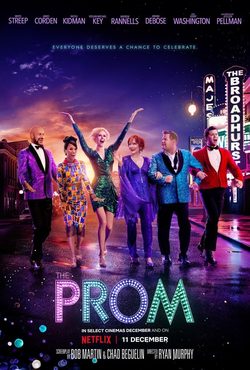Title: Prom
Released: December 2, 2020
Produced by: Ryan Murphy
Access on: Netflix
Netflix Summary: A group of down-on-their-luck Broadway stars shake up a small Indiana town as they rally behind a teen who just wants to attend prom with her girlfriend
Gaze Theory: This film is a perfect example of a movie that does not use gaze theory. This film is based on the struggles of a teenage girl in high school who faces discrimination because she is lesbian. Because the film is not meant to please the male audience members we do not see any instances of women being objectified. There may be a few scenes where women are sexualized but not in a way that makes them inhuman or objects.
Sex Role Theory: This movie is also a great example of deviation from gender roles and norms. First, much of the cast is portrayed as gay or lesbian. The main character, Emma, is a lesbian and she is dating a girl at school. The broadway cast that comes to help her also includes Barry and Trent who are gay men. Because of the immense amount og LGBTQ representation, the film contradicts many feminine and masculine stereotypes.
Effects: This film is a great example of a progessive movie for teens. Young teenage girls can be inspired to embrace their sexuality. It also teaches other teens how to accept, welcome and advocate for these minorities. Not only does it offer a great example, it may also be a comfort to some people who feel alone. It opens up a community for young LGBTQ members and helps them to not feel isolated and to make them feel worthy. Overall, this film does not objectify or sexualize women and offers an important perspective on the LGBTQ community.
Shared by: Olivia Smidel
Image Credit: https://en.wikipedia.org/wiki/The_Prom_(film)
